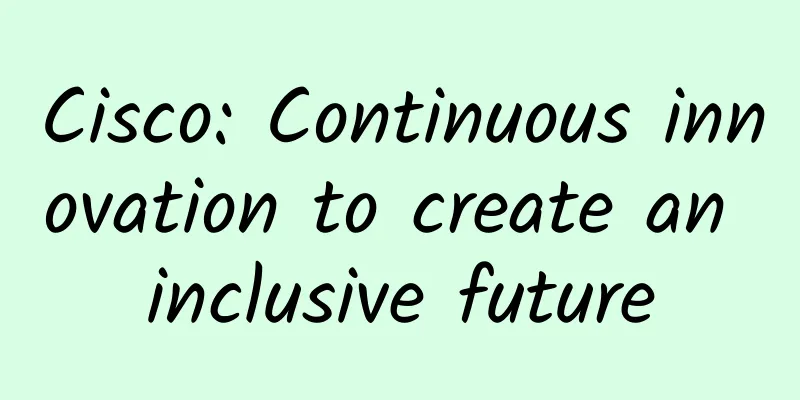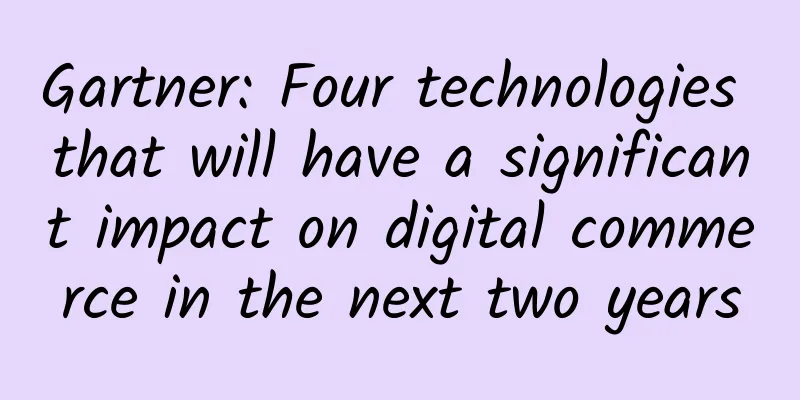Cisco: Continuous innovation to create an inclusive future

|
On June 14, Cisco's annual networking and security technology event "Cisco LIVE 2022" officially opened in Las Vegas, USA. The conference aims to create a Cisco community that showcases innovation, inspires inspiration and network technology. Hou Shengli, vice president of Cisco Greater China and general manager of the pre-sales engineer team, recently accepted an interview with reporters and gave a detailed introduction to Cisco's innovative technologies and optimized application portfolios in the fields of networking, security, and collaboration shared at "Cisco LIVE 2022", as well as how these technologies can help companies improve productivity, resilience and agility in today's online and offline hybrid world. Hou Shengli, Vice President of Cisco Greater China and General Manager of Pre-sales Engineering Team Achieving our goals to build an inclusive futureHou Shengli said that Cisco will help everyone build an inclusive future through continuous innovation. Inclusiveness is reflected in everything Cisco does, such as achieving the following goals: First, hybrid office. The epidemic has caused great changes in the management and operation methods of enterprises and the working mode of employees. The "hybrid office" mode has become normalized. Cisco has followed this trend and launched various technologies to support the realization of "hybrid office". Second, ubiquitous security protection and connectivity. As hybrid office becomes more popular, secure connections of corporate networks and personal devices have become very important. During the epidemic, user nodes of remote offices have become a weak link that is vulnerable to hacker attacks. Third, the net zero goal. Currently, governments around the world have proposed carbon neutrality goals. Cisco is committed to achieving the "net zero" goal by 2040. From IT architecture to supply chain model, from product life cycle management to infrastructure construction, Cisco has a complete technical solution to meet the needs of low-carbon zero emissions, and uses technological innovation to help customers achieve the development goals of "carbon neutrality" and "net zero". Fourth, make organizations efficient and innovative. Cisco helps companies operate efficiently and quickly through innovative technologies. Continuous innovation empowers enterprise digital transformationThe current IT environment has become very complex, user expectations have increased, and the number and diversity of connections that enterprises rely on have multiplied, which has led to a more fragmented network and overall IT experience, reduced security, and increasingly difficult to scale. Therefore, IT teams need a unified solution to bridge the organization's technology, location, team, and equipment to build business agility and resilience. Hou Shengli said that the relevant innovative achievements released at "Cisco LIVE 2022" can help enterprises effectively improve productivity and build business resilience and agility. To provide customers with a more consistent experience, they hope that the network will be simpler and smarter. Cisco has launched new cloud management capabilities that provide a consistent experience for the Cisco Meraki, Cisco Catalyst, and Cisco Nexus product portfolios, and has launched a new Cisco ThousandEyes product for proactively predicting and optimizing wide area network performance. This allows for better integration of the network and the cloud, and helps customers expand their ability to manage across public clouds, private clouds, and edge computing environments in a hybrid IT model. Cisco has announced its global cloud-delivered integrated platform plan, the Cisco Security Cloud, which can protect and connect enterprises of any shape and size. The Cisco Security Cloud will provide an integrated experience that securely connects people and devices in different places to applications and data anywhere. Through unified management, the open platform will provide scalable threat prevention, detection, response and repair capabilities. Hybrid Work Experience. Cisco introduced the industry's first hybrid office phone, the Cisco Video Phone 8875, which maximizes productivity and reduces meeting fatigue. Optimized Webex Calling has become part of the Webex Suite, increasing work flexibility, reliability, and optimizing audio capabilities. IT administrators can proactively manage application performance issues using the "Thousand Eyes" system integrated into the Webex Control Center, providing a better experience for Webex Suite users. Salesforce and Oracle Eloqua are now integrated into the Webex Webinars service to improve productivity through flexible workflows. AppDynamics Cloud provides excellent digital experience. Cisco launched AppDynamics Cloud. By correlating telemetry data from any cloud environment on a large scale, AppDynamics Cloud enables excellent digital experience. It makes full use of cloud-native observability to fix application performance problems through business scenario awareness and insight-driven measures. Cisco fully embraces open source and open IT environments. Cisco not only provides complete IT solutions and commercial equipment that everyone is familiar with, but also provides chips and basic SONiC operating systems to support customers in developing their own products; they can even reinstall SONiC software in existing equipment, that is, users can reinstall the operating system on the purchased commercial machines to meet customized needs. Cisco's cloud-native API-first tool suites Panoptica and Calisti can accelerate the application development cycle and provide enterprises with connectivity, security, and observability of modern applications. "Cisco's innovation and product direction are driven by real-world challenges, customer digital transformation needs and business pain points. Because today's business environment is unpredictable, companies and organizations need to rely on digital experiences to keep employees productive and ensure that they exceed expectations of customers and partners," Hou Shengli emphasized. Formulate strategies to unleash the power of “open” networksIn order to continuously enable enterprises to build business resilience and agility and help them smoothly carry out digital transformation, Cisco is actively building a diversified development strategy while continuously innovating in technology. One of the important ones is the open network development strategy, which core includes four aspects: industry-leading chips, industry-leading software, industry-leading systems, cloud and cloud native. Hou Shengli said that in terms of chips, Cisco has launched 11 Silicon One chips in the past 22 months. The API interfaces and physical interfaces of different chips are all the same. Customers can build various platforms such as switches and routers on a unified architecture and build their own customized products. In terms of software, Cisco has a commercial operating system IOS XR with fully layered and open APIs. According to the needs of customer business, secondary development can be done on it, and management and traffic control can be performed. In terms of systems, Cisco supports various commercial and open source network operating systems. Its modules and chips consume only a few or several tenths of the original energy, but the performance can better meet customer needs. In terms of cloud and cloud native, Cisco actively embraces open source and is an active participant and contributor to many open source projects. It also incubates many products based on open source projects, including Cisco Cloud Native Suite, management for cloud services, and security policies for cloud services. "Cisco believes that this is an era of 'cloud first'. Cloud is indispensable and unavoidable in IT, so Cisco actively embraces the changing trend of such a multi-cloud world." Hou Shengli emphasized. However, not all customers are suitable for open source network operations. Hou Shengli put forward several requirements for open source customers: First, customers have relatively clear needs and are clear about what special needs and special applications they need; second, customers must have relatively strong technical capabilities, whether they develop completely by themselves, through third-party partners, or need Cisco to customize according to their needs, they can clearly know how to implement the technology. "For those suitable customers, they will get a lot of benefits. We provide a lot of detailed analysis and security strategies, which can be customized according to their needs." Hou Shengli added. "Of course, in addition to requirements for customers, open source also has requirements for partners. Partners must have the ability to develop software and hardware. Cisco has a dedicated business development manager and team that will arrange corresponding training to support partners," said Hou Shengli. The core of open network is open software platform. Hou Shengli said: "Cisco has adopted a dual-wheel drive open network strategy of commercial software and open source software. In the commercial IOS software stack, modular software deployment and layered open interfaces bring convenient and flexible comprehensive software definition capabilities for commercial systems. For customers who only want to focus on business innovation rather than maintaining the entire network operating system, this is an excellent way to implement open network." In addition, Cisco also provides comprehensive software stack support for customers who want to use open source software to achieve full autonomy and control. Hou Shengli said that Cisco can provide complete SONiC underlying software stack support, including SAI interface, chip SDK, ONIE, BSP, etc., and combined with Cisco's professional support services, to accelerate the development of customers' own network operating systems and applications. "What's even better is that a set of chips and systems can switch between commercial systems and open source systems according to business development needs and technology maturity, so as to meet the different needs of customers and reduce risks." Hou Shengli emphasized. Open networks not only need to consider open source platforms, but also the openness of commercial systems. Through innovations in industry-leading chips, systems, network operating systems, cloud and container open source software, Cisco provides customers, partners and communities with the most comprehensive open capabilities to meet the open innovation requirements of different application scenarios. Hou Shengli emphasized that Cisco is committed to becoming the creator and innovator of the current and next-generation Internet and will do its best to achieve it. Quantum networks, artificial intelligence, metaverse and other technological fields are all directions for Cisco to explore in the future. Cisco's innovation not only focuses on the present, but also faces the future! |
<<: Understanding Cloud Networks in One Article
>>: 5G, IoT, edge and cloud: a winning combination
Recommend
ZgoCloud: $14/quarter-AMD Ryzen9, 1GB memory, 30G NVMe, Osaka, Japan data center
ZgoCloud domain name registration started in Apri...
Fifteen best practices for a successful data center migration
Data center migrations are often complex and risk...
How did the three major operators become involuted? Is it necessary for the three to merge to avoid involuntariness?
It is child's play for operator staff to ente...
CUBECLOUD Christmas 12% off, Hong Kong/Los Angeles CN2 GIA line VPS monthly payment starts from 60 yuan
I received a Christmas and New Year promotion fro...
How do you know if you are suitable for Wi-Fi 6 when it is about to be widely adopted?
Last year, the Wi-Fi Alliance broke the "rul...
ZJI: Hong Kong server special offer from 450 yuan/month-E5-2630L/16G memory/480G SSD/10M bandwidth/three-network direct connection
ZJI is currently offering a special promotion for...
Say goodbye gracefully - TCP protocol waves four times
Say goodbye gracefully Leaving without saying goo...
Unlimited data? 5G packages are more varied, watch out for your phone bills
The buyer is always the wisest, and it is well kn...
Relax and have fun during the Dragon Boat Festival. WiFi signal must be strong. Here's how to adjust it
[[405404]] During the Dragon Boat Festival holida...
How to manage data center cabling?
Tracking and managing data center cabling is one ...
Intermediate explanation of IP/TCP protocol, handshake process and data packet format
IP address definition: IP is known as Internet Pr...
CDN shifts from price war to technology war, will video cloud rewrite the market landscape?
Just as the rise of e-commerce was premised on th...
Wi-Fi 6 and 5G: Which is more secure, and where will our data go?
Historically, one of the biggest drawbacks of Wi-...
Ten areas you must know about 5G
The development of 5G is in full swing, and it ca...
Detailed explanation of the design points and principles of 6G system data governance solutions
This article is reprinted from the WeChat public ...









